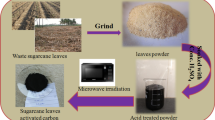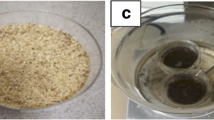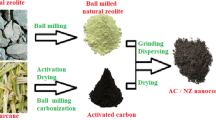Abstract
Crystal violet (CV), a cationic dye is not only toxic for plant and animals but also for human, due to its resistance to biodegradation. It is, therefore, highly important to remove CV dyes from water resources. Adsorption is cost-effective and ecofriendly technique to remove CV dyes. Herein, we report the synthesis of novel waste onion-based porous biosorbent and its chemical activation through KOH. N2 adsorption/desorption isotherms show that activated carbon was found to be highly mesoporous with average particles size of 17 nm. The BET surface area was calculated to be 292.8 m2/g. To characterize the materials for structural, morphological and thermal stability, various analytical techniques like X-ray diffraction, Fourier transform infrared spectroscopy, field emission scanning electron microscopy and thermogravimetric analysis were performed. For comparison purpose both carbon and activated carbon samples were used to remove CV dyes from water resources. Freundlich isotherm model provides the best correlation for adsorption of CV on both the samples. Monolayer adsorption capacity (qm) for carbon and activated carbon was 8.7 and 18.6 mg/g respectively, which declared that activated carbon is more effective adsorbent then carbon. To explore the mechanism of adsorption thermodynamics and spectroscopic analysis were investigated. Positive value of \(\Delta H\) and negative value of \(\Delta G\) indicated that reaction is endothermic and spontaneous. Value of Ea < 40 kJ/mol indicates that mechanism of adsorption is physisorption. Overall onion waste provides an effective and novel biosorbents for removal of crystal violet dye from water resources.











Similar content being viewed by others
References
Abbas S, Javeed T, Zafar S, Taj MB, Ashraf AR, Din MI (2021) Adsorption of crystal violet dye by using a low-cost adsorbent–peanut husk. Desalin Water Treat 233:387–398
Ali R, Aslam Z, Shawabkeh RA, Asghar A, Hussein IA (2020) BET, FTIR, and RAMAN characterizations of activated carbon from waste oil fly ash. Turk J Chem 44(2):279–295
Batool M, Javed T, Wasim M, Zafar S, Din MI (2021) Exploring the usability of Cedrus deodara sawdust for decontamination of wastewater containing crystal violet dye. Desalin Water Treat 224:433–448
Bazan A, Nowicki P, Półrolniczak P, Pietrzak R (2016) Thermal analysis of activated carbon obtained from residue after supercritical extraction of hops. J Therm Anal Calorim 125(3):1199–1204
Blachnio M, Derylo-Marczewska A, Charmas B, Zienkiewicz-Strzalka M, Bogatyrov V, Galaburda M (2020) Activated carbon from agricultural wastes for adsorption of organic pollutants. Molecules 25(21):5105
Castro JP, Nobre JRC, Napoli A, Bianchi ML, Moulin JC, Chiou BS, Orts WJ (2019) Massaranduba sawdust: a potential source of charcoal and activated carbon. Polymers 11(8):1276
Chinniagounder T, Shanker M, Nageswaran S (2011) Adsorptive removal of crystal violet dye using agricultural waste cocoa (Theobroma cacao) shell. Res J Chem Sci 2231:606X
Dutta S, Gupta B, Srivastava SK, Gupta AK (2021) Recent advances on the removal of dyes from wastewater using various adsorbents: a critical review. Mater Advances 2:4497–4531
Elhadiri N, Benchanaa M, Chikri R (2020) Activated carbon for dyes removal: modeling and understanding the adsorption process. J Chem 2020:2096834
Farma R (2019) Physical properties analysis of activated carbon from oil palm empty fruit bunch fiber on methylene blue adsorption. J Technomater Phy 1(1):67–73
Foroutan R, Peighambardoust SJ, Peighambardoust SH, Pateiro M, Lorenzo JM (2021) Adsorption of crystal violet dye using activated carbon of lemon wood and activated carbon/Fe3O4 magnetic nanocomposite from aqueous solutions: a kinetic, equilibrium and thermodynamic study. Molecules 26(8):2241
Idan IJ, Abdullah LC, Choong TS, Jamil SN (2018) Equilibrium, kinetics and thermodynamic adsorption studies of acid dyes on adsorbent developed from Kenaf core fiber. Adsorp Sci Technol 36(1–2):694–712
Imran MS, Javed T, Areej I, Haider MN (2022) Sequestration of crystal violet dye from wastewater using low-cost coconut husk as a potential adsorbent. Water Sci Technol 85(8):2295–2317
Islam T, Liu J, Shen G, Ye T, Peng C (2018) Synthesis of chemically modified carbon embedded silica and zeolite from rice husk to adsorb crystal violet dye from aqueous solution. Appl Ecol Environ Res 16(4):3955–3967
Joshi S, Pokharel BP (2013) Preparation and characterization of activated carbon from lapsi (Choerospondias axillaris) seed stone by chemical activation with potassium hydroxide. J Inst Eng 9(1):79–88
Karam FF, Hassan FF, Hessoon HM (2021) Adsorption of toxic crystal violet dye using (Chitosan-OMWCNTs) from aqueous solution. Pap Present J Phys: Conf Ser 1991:012015
Khalil H, Jawaid M, Firoozian P, Rashid U, Islam A, Akil H (2013) Activated carbon from various agricultural wastes by chemical activation with KOH: preparation and characterization. J Biobased Mater Bioenergy 7(6):708–714
Krika F, Krika A, Azizi A (2019) Arundo donax L. as a low-cost and promising biosorbent for the removal of crystal violet from aqueous media: kinetic, isotherm and thermodynamic investigations. Chem Rev Lett 2(2):59–68
Kyi PP, Quansah JO, Lee CG, Moon JK, Park SJ (2020) The removal of crystal violet from textile wastewater using palm kernel shell-derived biochar. Appl Sci 10(7):2251
Lellis B, Fávaro-Polonio CZ, Pamphile JA, Polonio JC (2019) Effects of textile dyes on health and the environment and bioremediation potential of living organisms. Biotechnol Res Innov 3(2):275–290
Loulidi I, Boukhlifi F, Ouchabi M, Amar A, Jabri M, Kali A, Aziz F (2020) Adsorption of crystal violet onto an agricultural waste residue: kinetics, isotherm, thermodynamics, and mechanism of adsorption. Sci World J. https://doi.org/10.1155/2020/5873521
Mani S, Bharagava RN (2016) Exposure to crystal violet, its toxic, genotoxic and carcinogenic effects on environment and its degradation and detoxification for environmental safety. Rev Environ Contam Toxicol Appl Pharmacol 237:71–104
Naseem T, Baig MM, Warsi MF, Hussain R, Agboola PO, Waseem M (2020) Mesoporous silica prepared via a green route: a comparative study for the removal of crystal violet from wastewater. Mater Res Express 8(1):015005
Shaikhiev IG, Kraysman NV, Sverguzova SV (2022) Onion (Allium cepa) processing waste as a sorption material for removing pollutants from aqueous media. Biointerface Res Appl Chem 12(3):3173–3185
Shamsuddin M, Yusoff N, Sulaiman M (2016) Synthesis and characterization of activated carbon produced from kenaf core fiber using H3PO4 activation. Procedia Chem 19:558–565
Sharma S, Kaur A (2018) Various methods for removal of dyes from industrial effluents: a review. Indian J Sci Technol 11(12):1–21
Taktak F, Ciğeroğlu Z, Güler B (2022) Preparation of a new zwitterionic sulfobetaine methacrylate based superabsorbent copolymer hydrogel and its adsorption behavior toward cationic and anionic dyes. J Macromol Sci Part B 61(2):137–159
Wazir AH, Haq IU, Manan A, Khan A (2020) Preparation and characterization of activated carbon from coal by chemical activation with KOH. Int J Coal Prep Util 42(5):1477–1488
Author information
Authors and Affiliations
Corresponding author
Ethics declarations
Conflict of interests
The authors declare that they have no conflict of interest.
Additional information
Publisher's Note
Springer Nature remains neutral with regard to jurisdictional claims in published maps and institutional affiliations.
Rights and permissions
Springer Nature or its licensor (e.g. a society or other partner) holds exclusive rights to this article under a publishing agreement with the author(s) or other rightsholder(s); author self-archiving of the accepted manuscript version of this article is solely governed by the terms of such publishing agreement and applicable law.
About this article
Cite this article
Bibi, F., Sattar, A., Hussain, S. et al. Tailoring the sorption properties of crystal violet by activated carbon extracted from waste onion. Chem. Pap. 77, 3957–3966 (2023). https://doi.org/10.1007/s11696-023-02756-w
Received:
Accepted:
Published:
Issue Date:
DOI: https://doi.org/10.1007/s11696-023-02756-w




